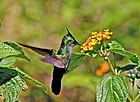Note: This is a project under development. The articles on this wiki are just being initiated and broadly incomplete. You can Help creating new pages.
Lantana camara
Lantana camara is a scrambling, thorny, evergreen shrub. It can grow up to 2 metres tall and perhaps 2.5 metres wide. Some forms of the plant are able to climber into other plants for support and thus reach greater heights. The plant is widely used in domestic medicine. It is commonly cultivated as an ornamental in tropical gardens, where it is also grown as a hedge plant. This herb is belongs to Verbenaceae family.
Uses
Skin itches, Wounds, Leprosy, Scabies, Tuberculosis, Asthma, Toothache, Headache, Inflammation, Gonorrhoea, Leucorrhoea.[1]
Food
Lantana camara can be used in Food. Ripe fruits are eaten raw.[2]
Parts Used
Chemical Composition
It contains triterpenoids, steroids, alkaloids, flavonoids, tannins etc.[3]
Common names
| Language | Common name |
|---|---|
| Kannada | Kaadujola, Kasuthi hoo |
| Hindi | Raimuniya |
| Malayalam | |
| Tamil | Unnichedi |
| Telugu | Pulikampa |
| Marathi | Tantani |
| Gujarathi | |
| Punjabi | |
| Kashmiri | |
| Sanskrit | |
| English | Lantana |
Properties
Reference: Dravya - Substance, Rasa - Taste, Guna - Qualities, Veerya - Potency, Vipaka - Post-digesion effect, Karma - Pharmacological activity, Prabhava - Therepeutics.
Dravya
Rasa
Guna
Veerya
Vipaka
Karma
Prabhava
Nutritional components
Lantana camara Contains the Following nutritional components like - Vitamin-B and C; Saponins; Tannins; Flavonoids; Glycosides; Calcium, Iron, Magnesium, Manganese, Phosphorus, Potassium, Sodium, Zinc[2]
Habit
Identification
Leaf
| Kind | Shape | Feature |
|---|---|---|
Flower
| Type | Size | Color and composition | Stamen | More information |
|---|---|---|---|---|
| {{{5}}} |
Fruit
| Type | Size | Mass | Appearance | Seeds | More information |
|---|---|---|---|---|---|
Other features
List of Ayurvedic medicine in which the herb is used
Where to get the saplings
Mode of Propagation
How to plant/cultivate
Grows in a wide variety of habitats in the tropical and subtropical zones. It has succeeded in areas where the annual rainfall is around 750mm, though is then usually found along creek lines[6]. Lantana camara is available through November to May[2].
Commonly seen growing in areas
Photo Gallery
References
- ↑ Indian Medicinal Plants by C.P.Khare
- ↑ 2.0 2.1 2.2 "Forest food for Northern region of Western Ghats" by Dr. Mandar N. Datar and Dr. Anuradha S. Upadhye, Page No.91, Published by Maharashtra Association for the Cultivation of Science (MACS) Agharkar Research Institute, Gopal Ganesh Agarkar Road, Pune
- ↑ Chemical constituents
- ↑ Karnataka Aushadhiya Sasyagalu By Dr.Maagadi R Gurudeva, Page no:315
- ↑ [Morphology]
- ↑ Cultivation
External Links
- Ayurvedic Herbs known to be helpful to treat Skin itches
- Ayurvedic Herbs known to be helpful to treat Wounds
- Ayurvedic Herbs known to be helpful to treat Leprosy
- Ayurvedic Herbs known to be helpful to treat Scabies
- Ayurvedic Herbs known to be helpful to treat Tuberculosis
- Ayurvedic Herbs known to be helpful to treat Asthma
- Ayurvedic Herbs known to be helpful to treat Toothache
- Ayurvedic Herbs known to be helpful to treat Headache
- Ayurvedic Herbs known to be helpful to treat Inflammation
- Ayurvedic Herbs known to be helpful to treat Gonorrhoea
- Ayurvedic Herbs known to be helpful to treat Leucorrhoea
- Herbs with Stems used in medicine
- Herbs with Roots used in medicine
- Herbs with common name in Kannada
- Herbs with common name in Hindi
- Herbs with common name in Tamil
- Herbs with common name in Telugu
- Herbs with common name in Marathi
- Herbs with common name in English
- Habit - Evergreen shrub
- Index of Plants which can be propagated by Seeds
- Index of Plants which can be propagated by Cuttings
- Herbs that are commonly seen in the region of Plantation crops
- Herbs that are commonly seen in the region of Moist habitats
- Herbs
- Pages without herbs images





